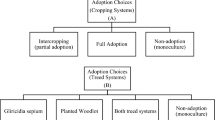Abstract
Yard care is an economically important household production activity that also has potentially significant environmental or health impacts. Of particular concern are the possible negative impacts of using synthetic pesticides and fertilizers. But economic models and empirical analyses of yard care and chemical use are rare. We develop a simple model of household production and consumption to analyze yard care and chemical use. We then estimate a multinomial logit model of these behavioral choices with household data from San Francisco. Attitudes towards the quality of one's outdoor residential environment and time scarcity are important determinants of the odds of chemical use whereas financial variables play the major role in determining the odds that people have and care for yards. These results could help to improve educational or marketing campaigns that aim to reduce potential or actual problems associated with yard chemical use. Better data for models similar to this one are needed for future research.
Similar content being viewed by others
References
Assing, J. V. (1994), Alameda County Urban Runoff Clean Water Program Survey of Public Attitudes and Awareness. Prepared for Alameda County Urban Runoff Clean Water Program and Ketchum Communications, April 20.
Bailey, H. C., J. L. Miller, M. J. Miller, L. C. Wiborg, L. Deanovic and T. Shed (1997), ‘Joint Acute Toxicity of Diazinon and Chlorpyrifos to Ceriodaphnia dubia’, Environmental Toxicology and Chemistry 16(11), 2304-2308.
Beasley, V. R. (1993), ‘Pesticides and Pets’, in K. D Racke and A. R. Leslie (eds.), Pesticides in Urban Environments: Fate and Significance, ch. 29. ACS Symposium Series No. 522. Washington, DC: American Chemical Society.
Becker, G. (1965), ‘A Theory of the Allocation of Time’, Economic Journal 75(299), 493-517.
Brewer, L. W., R. A. Hummell and R. J. Kendall (1993), ‘Avian Response to Organophosphorus Pesticides Applied to Turf’, in K. D Racke and A. R. Leslie (eds.), ibidem, ch. 27.
Cheshire, P. and S. Sheppard (1995), ‘On the Price of Land and the Value of Amenities’, Economica 62(246), 247-267.
Creason, J. R. (1992), Lawn Chemicals as a Joint Commodity: Public and Private Goods and Bads. St. Paul, Minnesota: Department of Agricultural and Applied Economics.
CSA (1995) California Statistical Abstract, 36th edn. California Department of Finance, Financial and Economic Research Unit, November.
DDI (1995), King County Household Hazardous Waste Survey 1994. Decision Data Inc.
DeLeon, R., B. Nixon, M. Medford, M. Martinez, K. Crew, J. M. Barron, B. Colby and E. Balbour (1994) Best Management Practices and Educating the Public about the Use and Safe Disposal of Household Toxic Products: A Survey of San Francisco Households, PRI Report 94-5. San Francisco: Public Affairs Management and Public Research Institute, San Francisco State University.
EPA (1996a), Environmental Health Threats to Children, EPA 175-F-96-001. Office of the Administrator (1101), U.S. Environmental Protection Agency, September.
EPA (1996b), Major Issues in the Food Quality Protection Act of 1996. Office of Prevention, Pesticides, and Toxic Substances, U.S. Environmental Protection Agency.
Frankie, G.W., R.M. Mandel, H. Levenson and T. A. Granovsky (1981), ‘A Survey of the Arthropod Pests and Measures to Control Them in Three Metropolitan Areas’, in Proceedings of an Urban Integrated Pest Management Workshop. Dallas, Texas: National Cooperative Extension.
Henry, M. S. (1994), ‘The Contribution of Landscaping to the Price of Single Family Homes: A Study of Home Sales in Greenville, South Carolina’, Journal of Environmental Horticulture 12(2), 65-70.
Levenson, H. and G. W. Frankie (1983), ‘A Study of Homeowner Attitudes and Practices Toward Arthropod Pests and Pesticides in Three U.S. Metropolitan Areas’, in G. W. Frankie and C. S. Koehler (eds.), Urban Entomology: Interdisciplinary Perspectives. New York: Praeger Publishers.
Lowengart, R. A., J. M. Peters, C. Cicioni, J. Buckley, L. Bernstein, S. Preston-Martin and E. Rappaport (1987), ‘Childhood Leukemia and Parents' Occupational and Home Exposures’, Journal of the National Cancer Institute 79(1), 39-46.
MSRCI (1994), Sewer Pollution Survey. Conducted by Marchione and Spero Research Center, Inc. for the Central Contra Costa Sanitary District, March.
NGA (1996), National Gardening Survey, 1995–1996. Conducted by the Gallup Organization, Inc. for the National Gardening Association.
Potter, D. A. (1993), ‘Pesticide and Fertilizer Effects on Beneficial Invertebrates and Consequences for Thatch Degradation and Pest Outbreaks in Turfgrass’, in K. D Racke and A. R. Leslie (eds.), ibidem, ch. 28.
Whitmore, R. W., J. E. Kelly and P. L. Reading (1992), National Home and Garden Pesticide Use Survey Final Report, Volume I: Executive Summary, Results, and Recommendations. RTI/5100/17-01F, Research Triangle Institute, March.
Author information
Authors and Affiliations
Rights and permissions
About this article
Cite this article
Templeton, S.R., Yoo, S.J. & Zilberman, D. An Economic Analysis of Yard Care and Synthetic Chemical Use: The Case of San Francisco. Environmental and Resource Economics 14, 385–397 (1999). https://doi.org/10.1023/A:1008323827326
Issue Date:
DOI: https://doi.org/10.1023/A:1008323827326




